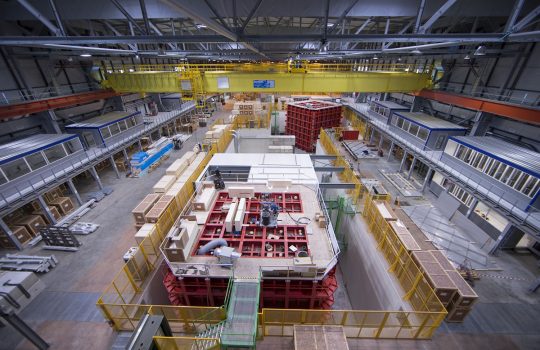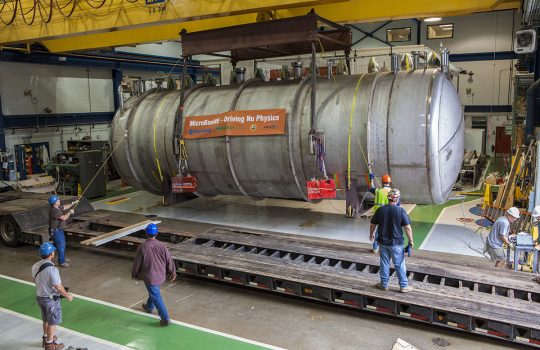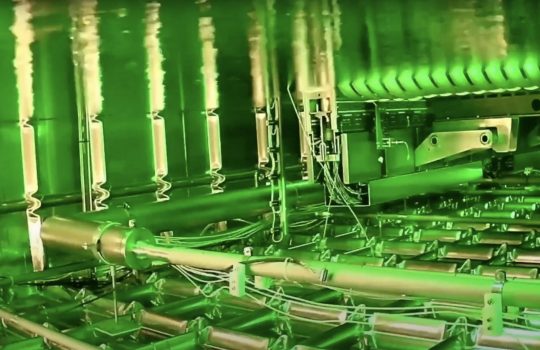Construction workers have finished the excavation of the huge caverns that will house the international Deep Underground Neutrino Experiment. While engineers and technicians are preparing for the installation of the gigantic neutrino detectors into these caverns a mile underground, scientists around the world are working to optimize DUNE’s particle detector technology.
From new photon detection systems to improved detector designs, researchers are refining devices and technologies to make DUNE’s neutrino detectors — liquid-argon time projection chambers — the best they can be for the most precise neutrino measurements.
The purity of the liquid argon inside the DUNE cryostats, which is crucial to observing particles and light created by neutrino interactions in the liquid, might get an upgrade too. An interdisciplinary team of researchers in Brazil discovered that a filter media typically used in industrial applications can filter out nitrogen contamination in liquid argon. Future large-scale tests will help determine whether this promising method might be applicable for DUNE.
“We started with the goal of finding new materials that could capture oxygen and water in a more efficient way,” said lead researcher Pascoal Pagliuso, a physics professor at “Gleb Wataghin” Institute of Physics, Unicamp in Campinas-São Paulo. “We decided to try and find a way to capture nitrogen, too. And we succeeded.”
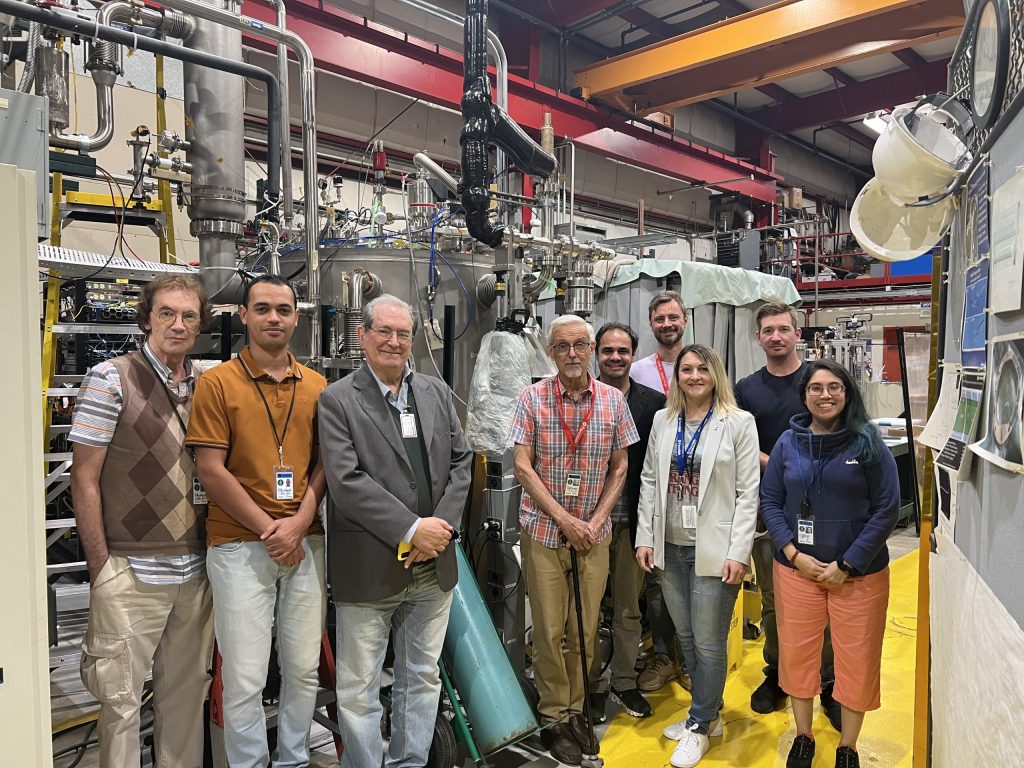
Researchers from Fermilab and Brazil pose with the ICEBERG test stand at Fermilab to commemorate the testing of a new filter technology for removing nitrogen from liquid argon. From left: Helio Da Motta, Daniel Souza Correia, Dilson Cardoso, Carlos Escobar, Pascoal Pagliuso, Sergey Koshelev, Roza Doubnik, Robert Mrowca and Flor de Maria Blaszczyk. Photo: Courtesy of Roza Doubnik
Neutrinos are the most abundant matter particles in the universe, yet they are hard to detect. For DUNE scientists to observe some of the neutrinos flying through their gigantic particle detectors, the neutrinos must interact with something. In the case of DUNE, hosted by the U.S. Department of Energy’s Fermi National Accelerator Laboratory, neutrinos will collide with argon atoms. The process creates secondary particles that knock loose electrons and emit brief flashes of scintillation light. Instruments can record the electrons and light so that scientists can identify and reconstruct the particles and tracks that the collisions produce. However, for this measurement to happen, the particles need to have a clear, unobstructed path through the liquid argon all the way to the detection devices. In particular, the liquid argon has to be ultra-pure and contain few atoms of other elements that could absorb electrons or light.
A tricky challenge
Researchers and engineers ensure that the liquid argon in the detectors is as pure as it can be by filtering out contaminants like water and oxygen. These are two of the most common impurities. However, there’s a third contaminant that is common: nitrogen. While neutrino researchers have well-established methods to filter out water and oxygen, reducing nitrogen levels below the levels provided by commercial providers has been a challenge.
Nitrogen can have a significant impact on the results of experiments — up to 20% of scintillation light can be lost even with just one part per million of nitrogen present in liquid argon. With ambitious experiments such as DUNE, ensuring the quality of all detector components and materials to produce the best results is critical to finding out more about neutrinos and their role in the subatomic world.
Fermilab currently uses a molecular sieve and a copper material to filter out water and oxygen, respectively, but neither can capture nitrogen from liquid argon.
Led by Pagliuso, researchers in Brazil discovered a way to reduce even small contamination levels of nitrogen in liquid argon. His interdisciplinary team of physicists and engineers found a material that removes both nitrogen and water.
Combined with a filter media like the copper material used by Fermilab, the media can remove the three most common liquid-argon contaminants, ensuring the argon is as pure as possible for neutrino experiments.
The material is known as Lithium-FAU, a Faujasite LiX zeolite. This type of aluminosilicate material has industrial applications in refining petroleum and purifying air. The Brazilian team discovered it also has the ability to remove nitrogen from liquid argon through adsorption. “It’s like when you have a medicine for one disease and discover that it also works for another disease,” Pagliuso said.
When zeolites are used as adsorbents to refine or purify liquids and gases, they attract particular particles that will stick to their surface while allowing others to pass through the crystalline structure. It’s the concept also applied when putting packets of silica gel in new shoes to capture moisture: water clings to the surface of the silica gel beads so that the humidity won’t damage the shoes. In this case, the nitrogen molecules interact with the positively charged ions in the zeolite; the size of the lithium molecules is small enough to leave room for the nitrogen to be captured and for the liquid argon to flow free of contaminants.
The chemical engineering branch of the research team at Unicamp developed simulations to predict how nitrogen would be adsorbed by Li-FAU, giving DUNE experimenters the necessary framework for testing how the media performs in the specific environment of liquid argon in a cryostat.
“Predicting the behavior of the filter is important to determine the capacity of the filter,” said Dirceu Noriler, a professor and Director of the School of Chemical Engineering at Unicamp. “We helped the engineers design the filter by specifying the saturation time and number of cycles needed to reach the required purity.”
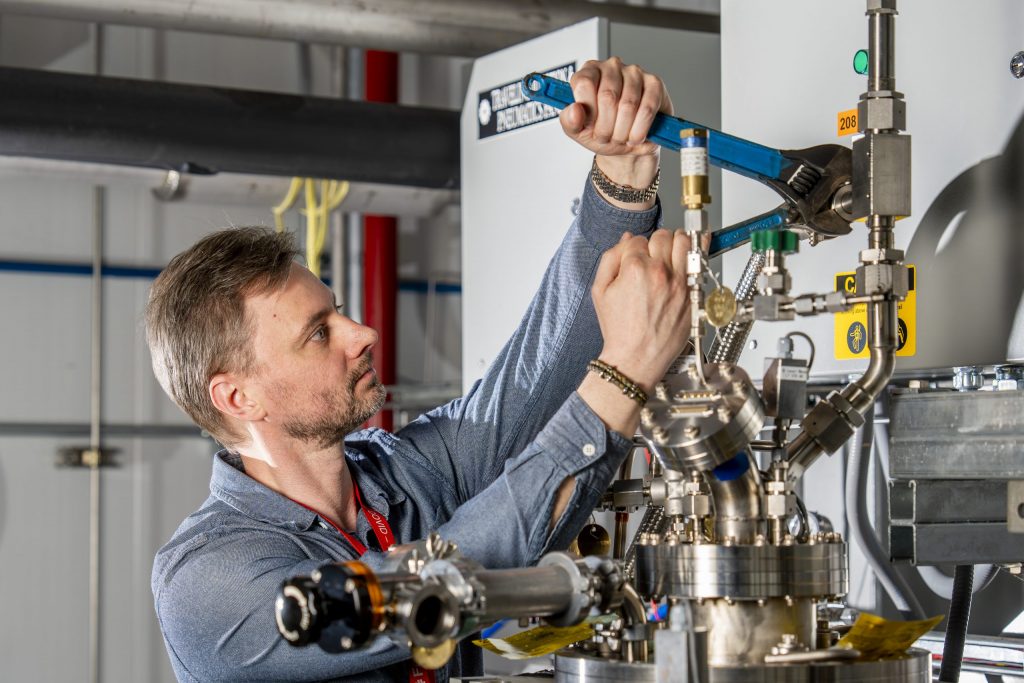
Fermilab engineer Sergey Koshelev works on equipment that regenerates the filters used for purifying liquid argon. Photo: Dan Svoboda, Fermilab
Successful tests
Researchers and engineers initially tested the media in the relatively small Liquid Argon Purification Cryostat at Unicamp with approximately 90 liters of liquid argon. Their successful results matched the simulations Noriler and his team had developed. Further testing took place this past fall at the 3000-liter ICEBERG test stand in Fermilab’s Noble Liquid Test Facility, which was filled with 2,625 liters of liquid argon for this particular test. The results confirmed Li-FAU’s ability to remove nitrogen from liquid argon at a larger scale.
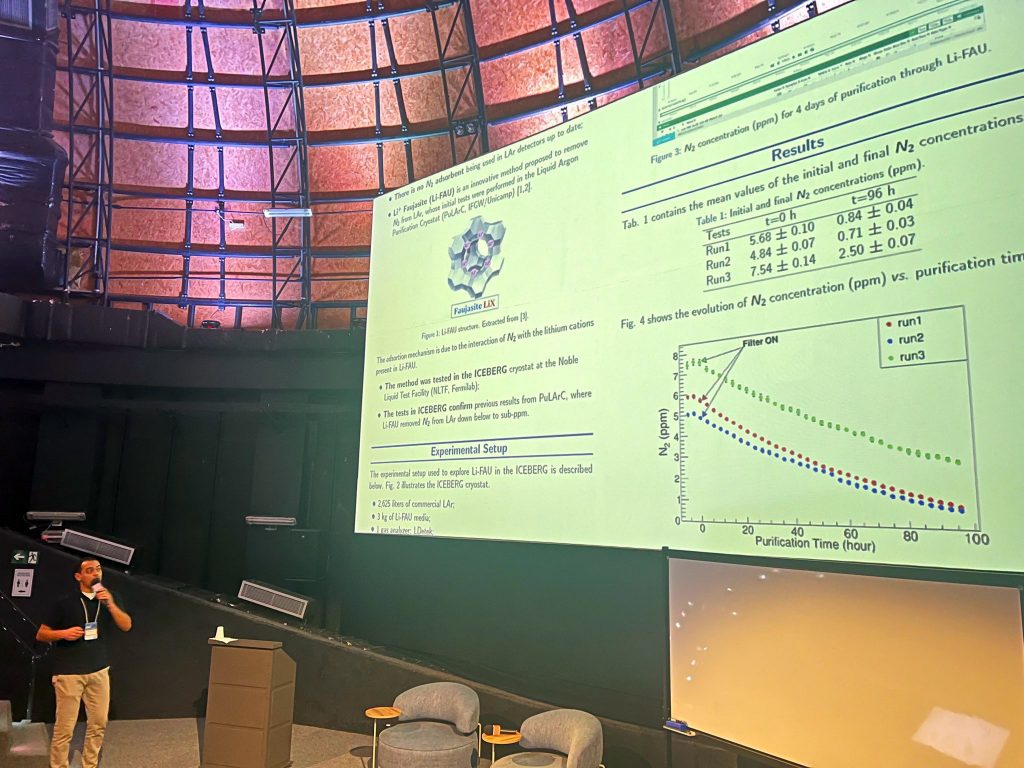
At an international workshop in Sao Paolo, Brazil last April, Daniel Souza Correia, a student at the Brazilian Center for Research in Physics, presented the results of removing contaminants from liquid argon with a material known as Lithium-FAU. Photo: Adrian Lozano Sanchez
“The Noble Liquid Test Facility here at Fermilab supports all sorts of liquid argon detector R&D, and we were very happy with the results. We intend to add Li-FAU to the facility as soon as possible so that, in addition to DUNE, all projects working on improving light collection systems can benefit,” said Flor de María Blaszczyk, R&D coordinator and test facility manager at Fermilab.
Not only will the purification media improve the quality of the liquid argon that Fermilab uses for experiments, but it would also allow for the removal of nitrogen contaminants if air would accidentally be introduced into the cryostat due to the malfunction of equipment. Nitrogen is the most abundant element in air, so knowing how to filter it out will be crucial for ensuring DUNE and other experiments won’t be compromised.
The next step is working to scale up the testing with larger volumes of liquid argon to ensure the media performs as well as it has so far. Scientists hope that ultimately the method will be capable of removing nitrogen at the large scale required for DUNE, which will feature detector modules that each contain 17,500 tons of liquid argon.
Fermi National Accelerator Laboratory is supported by the Office of Science of the U.S. Department of Energy. The Office of Science is the single largest supporter of basic research in the physical sciences in the United States and is working to address some of the most pressing challenges of our time. For more information, please visit science.energy.gov.

